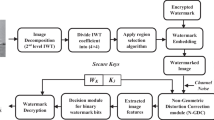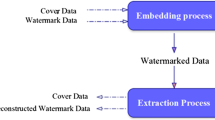Abstract
A new blind digital image watermarking algorithm with watermark embedded in discrete cosine transform (DCT) coefficients is presented in this paper. The proposed scheme exploits correlation between DCT coefficients in neighborhood blocks for embedding. The watermark is embedded by modifying two DCT coefficients, one pertaining to a block in which watermark bit (0 or 1) is to be embedded and the other corresponding to the selected neighborhood block. Both the selected coefficients are modified by a modification factor so that the difference between the pair of coefficients is brought to a predefined zone. This difference between two DCT coefficients is used to extract watermark. The proposed technique has been tested for different attacks like JPEG compression, rotation, cropping, filtering, gaussian noise, salt and pepper noise, histogram equalization etc. It has been observed that the scheme is highly robust not only for the above mentioned attacks used singularly, but also for different possible combinations of simultaneous attacks. A comparison of the proposed technique with some state of art existing algorithms reveals that our scheme provides better results in terms of quality of watermarked images, payload and robustness.























Similar content being viewed by others
References
Bhat, G. M., Parah, S. A., & Sheikh, J. A. (2010). FPGA implementation of novel complex PN code generator based data scrambler and descrambler. International, Journal of Science and Technology, 4(01), 125–135.
Castiglione, A., Pizzolante, R., Santis, A. D., Carpentieri, B., Castiglione, A., & Palmieri, F. (2015). Cloud-based adaptive compression and secure management services for 3D healthcare data. Future Generation Computer Systems, 43–44(2015), 120–134.
Cox, I., Kilian, J., Leighton, T., & Shamoon, T. (1997). Secure spread spectrum watermarking for multimedia. IEEE Transactions on Image Processing, 6, 1673–1687.
Das, C., Panigrahi, S., Sharma, V. K., & Mahapatra, K. K. (2014). A novel blind robust image watermarking in DCT domain using inter-block coefficient correlation. International Journal of Electronics and Communications (AEÜ), 68, 244–253.
Elbadri, M., Peterkin, R., Groza, V., Ionescu, D., & Saddik, A. E. (2005). Hardware support of JPEG. In: Proceedings of Canadian conference on electrical and computer engineering (pp. 812–815).
Fazli, S., & Moeini, M. (2016). A robust image watermarking method based on DWT, DCT, and SVD using a new technique for correction of main geometric attacks. Optik, 127, 964–972.
Guo, J., Zheng, P., & Huang, J. (2015). Secure watermarking scheme against watermark attacks in the encrypted domain. Journal of Visual Communication and Image Representation, 30, 125–135.
Hsu, C. T., & Wu, J. L. (1999). Hidden digital watermarks in images. IEEE Transactions on Image Processing, 8, 58–68.
Kalantari, N. K., Ahadi, S. M., & Vafadust, M. (2010). A robust image watermarking in the ridgelet domain using universally optimum decoder. IEEE Transactions on Circuits and Systems for Video Technology, 20, 396–406.
Kang, X., Huang, J., Shi, Y. Q., & Lin, Y. (2003). A DWT-DFT composite watermarking scheme robust to both affine transform and JPEG compression. IEEE Transactions on Circuits and Systems for Video Technology, 13(8), 776–786.
Lang, J., & Zhang, Z. (2014). Blind digital watermarking method in the fractional Fourier transform domain. Optics and Lasers in Engineering, 53, 112–121.
Lee, J. S., & Li, B. (2014). Image protection technique that resists large scale cropping (pp. 60–73). Jan-Mar: IEEE MultiMedia.
Lin, S. D., & Chen, C. F. (2000). A robust DCT-based watermarking for copyright protection. IEEE Transactions on Consumer Electronics, 46, 415–21.
Lin, S. D., Shie, S. C., & Guo, J. Y. (2010). Improving the robustness of DCT-based image watermarking against JPEG compression. Computer Standards & Interfaces, 32, 54–60.
Li, Z., Yap, K. H., & Lei, B. Y. (2011). A new blind robust image watermarking scheme in SVD-DCT composite domain. In: Proceedings of 2011 18th IEEE international conference on image processing (ICIP) (pp. 2757–2260).
Lu, Z. M., Zheng, H. Y., & Huang, J. (2007). A digital watermarking scheme based on DCT and SVD. In: Proceedings of third international conference on intelligent information hiding and multimedia signal processing (pp. 241–244).
Ma, F., Zhang, J. P., Zhang, W. (2012). A blind watermarking technology based on DCT domain international conference on computer science and service system (pp. 398–401).
Parah, S. A., Sheikh, J. A., & Bhat, G. M. (2014). Fragility Evaluation of Intermediate Significant Bit Embedding (ISBE) Based Digital Image Watermarking Scheme for Content Authentication (pp. 1–6). ICEACC, Reva Banglore: IEEE international conference proceeding.
Parah, S. A., Sheikh, J. A., Ahad, F., Loan, N. A., & Bhat, G. M. (2015). Information hiding in medical images: A robust medical image watermarking system for E-healthcare. Multimedia Tools and Applications . doi:10.1007/s11042-015-3127-y.
Parah, S. A., Sheikh, J. A., & Bhat, G. M. (2012). On the realization of a secure, high capacity data embedding technique using joint top-down and down- top embedding approach. Computer Science and Engineering, 49, 10141–10146.
Parah, S. A., Sheikh, J. A., Hafiz, A. M., & Bhat, G. M. (2014). Data hiding in scrambled images: A new double layer security data hiding technique. Computers and Electrical Engineering, 40, 70–82.
Patra, J. C., Phua, J. E., & Bornand, C. (2010). A novel DCT domain CRT-based watermarking scheme for image authentication surviving JPEG compression. Digital Signal Process, 20, 1597–611.
Pizzolante, R., Castiglione, A., Carpentieri, B., Santis, A. D., Palmieri, F., & Castiglione, A. (2015). Format-independent protection of DNA microarray images. In 2015 IEEE 10th international conference on P2P, parallel, grid, cloud and internet computing (pp. 351–357). doi:10.1109/3PGCIC.2015.138.
Run, R. S., Horng, S. J., Lai, J. L., Kao, T. W., & Chen, R. J. (2012). An improved SVD based watermarking technique for copyright protection. Expert Systems with Applications, 39(1), 673–689.
Sadreazami, H., & Amini, M. (2012). A robust spread spectrum based image watermarking in ridgelet domain. AEU International Journal of Electronics and Communications, 66, 364–371.
Schyndel, R. G., Tirkel, A. Z., & Osborne, C. F. (1996). A digital watermarking. Proceedings of IEEE International Conference on Image Processing, 2, 86–90.
Sun, L., XU, J., Liu, S., Zhang, S., Li, Y., & Shen, C., (2016). A robust image watermarking scheme using Arnold transform and BP neural network. Neural Computing and Applications. doi:10.1007/s00521-016-2788-4.
Wallace, G. K. (1992). The JPEG still picture compression standard. IEEE Transactions on Consumer Electronics, 38, 18–24.
Wu, N. I., & Hwang, M. S. (2007). Data hiding: Current status and key issues. International Journal of Network Security, 4, 1–9.
Acknowledgements
The authors would like to thank the Department of Science and Technology (DST) New Delhi, and University Grants Commission (UGC), New Delhi for supporting this research under DST inspire fellowship and SAP schemes.
Author information
Authors and Affiliations
Corresponding author
Rights and permissions
About this article
Cite this article
Parah, S.A., Sheikh, J.A., Loan, N.A. et al. Utilizing neighborhood coefficient correlation: a new image watermarking technique robust to singular and hybrid attacks. Multidim Syst Sign Process 29, 1095–1117 (2018). https://doi.org/10.1007/s11045-017-0490-z
Received:
Revised:
Accepted:
Published:
Issue Date:
DOI: https://doi.org/10.1007/s11045-017-0490-z




